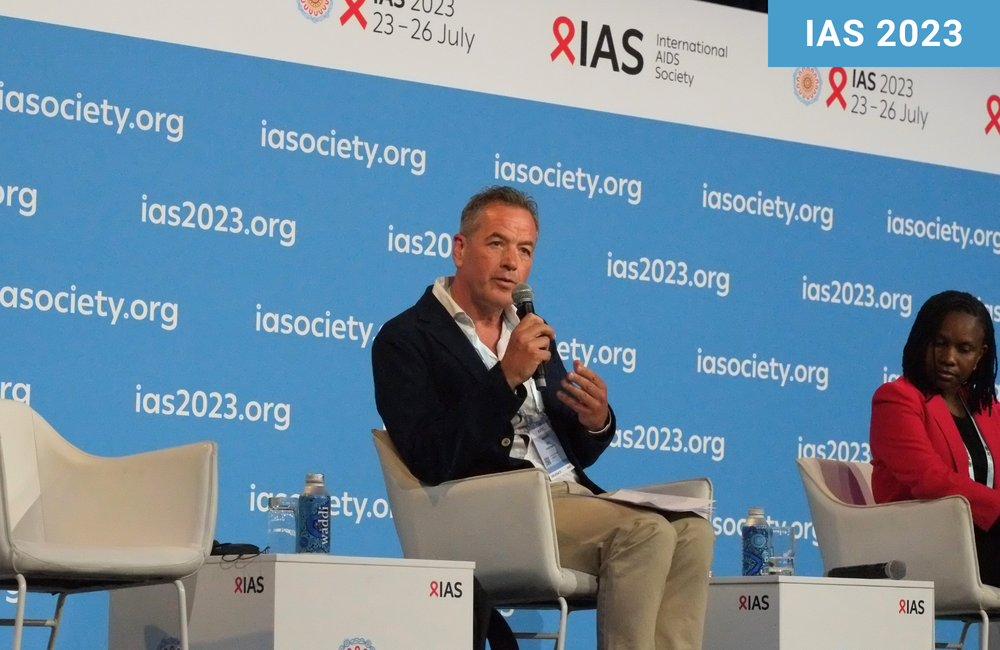
Ninety-five per cent of people who experienced viral load rebound while taking dolutegravir in a large clinical trial in South Africa were able to re-suppress viral load with the help of adherence counselling and did not need to switch treatment, Dr Andrew Hill of the University of Liverpool reported last week at the 12th International AIDS Society Conference on HIV Science (IAS 2023) in Brisbane, Australia.
The findings suggest that if people are having adherence difficulties when taking the world’s most commonly prescribed antiretroviral drug, switching treatment may not prove helpful, whereas addressing their adherence difficulties ensures that people with HIV can stay on a simple, affordable antiretroviral regimen for longer.
Recommended by the World Health Organization (WHO) for its high potency and low risk of drug resistance, the integrase inhibitor dolutegravir forms part of HIV treatment for approximately 20 million people worldwide. Dolutegravir is usually taken as part of a fixed-dose combination with two other drugs.
Treatment guidelines recommend that if people with HIV taking a non-nucleoside reverse transcriptase inhibitor (NNRTI) such as efavirenz experience viral rebound above 1,000 copies/ml, they should be switched to another regimen. Resistance to NNRTIs develops quickly after viral load rebound, so switching at this level is usually essential, especially if viral load testing is caried out once a year.
Resistance to dolutegravir develops less easily. WHO guidance recommends that in cases of viral load rebound above 1000, the alternative approach is to provide enhanced adherence counselling and carry out a viral load test three months later, to check for re-suppression.
But it’s unclear how effective this approach to managing viral rebound might be in people taking dolutegravir. If it is ineffective, it risks exposing a large number of people to the risk of developing resistance to an integrase inhibitor.
“There is a saying, ‘don’t put all your eggs in one basket’,” Dr Hill told the conference. “We are putting 20 million eggs in one basket, so we need to be very careful about how we manage treatment failure.”
To investigate the effectiveness of the WHO guidance, researchers looked at the outcomes of people who experienced viral rebound above 1000 in the ADVANCE study. The trial compared two dolutegravir-based regimens with an efavirenz-based regimen in 1053 people with HIV in South Africa who had not previously taken HIV treatment.
Participants did not stop treatment and leave the study when they experienced viral rebound.
The study compared the time to first viral suppression, time to viral rebound and time to viral re-suppression in study participants using a Kaplan-Meier analysis, which plots the probability of events over time.
Although viral suppression was faster in dolutegravir recipients than those on efavirenz, there was no significant difference in the proportions who achieved viral suppression by weeks 24 and 48.
The rate of virologic failure, defined as one viral load measurement above 1000 more than 24 weeks after randomisation, did not differ significantly during 192 weeks of follow-up.
However, the rate of viral re-suppression was significantly higher in the dolutegravir recipients compared to the efavirenz recipients at week 24. Eighty-eight per cent of dolutegravir recipients and 46% of efavirenz recipients re-suppressed viral load by week 24 and 95% of dolutegravir recipients and 66% of efavirenz recipients had done so by week 48. However, the proportion of people who remained on efavirenz after viral rebound was smaller, Andrew Hill said. An unspecified number switched to a boosted protease inhibitor.
Whereas prolonged treatment with efavirenz after viral rebound is associated with a high risk of developing resistance not only to efavirenz but also to drugs in the NRTI backbone, phase III studies of dolutegravir in people who had not previously taken HIV treatment showed no cases of integrase inhibitor resistance after virologic failure. The rate of development of NRTI resistance after virologic rebound was very low, Dr Hill said. Even in second-line treatment studies, the incidence of integrase inhibitor resistance was low, he added.
The study investigators say their findings support the recent South African guidelines, which recommend that people with viral rebound should only be switched from dolutegravir if they have integrase inhibitor resistance mutations. This guidance may not be appropriate for settings where access to resistance testing is limited, or non-existent. Further evidence is needed about the amount of adherence counselling that should be provided and the duration of detectable viral load that should be tolerated before switching treatment, the study investigators say.
Bosch B et al. High rates of long-term HIV RNA re-suppression after virological failure on dolutegravir in the ADVANCE trial. 12th International AIDS Society Conference on HIV Science (IAS 2023), Brisbane, Australia, abstract OAB0204, 2023.
